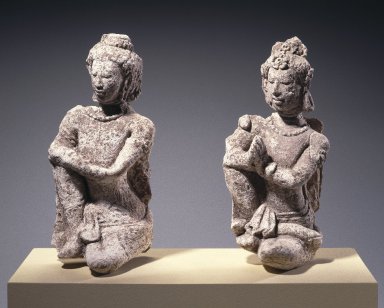
Medium: Stucco
Geograhical Locations:
Dates:ca. 7th–8th century
Dimensions: 10 1/2 x 5 1/4 x 4 in. (26.7 x 13.3 x 10.2 cm)
Collections:
Museum Location: Asian Galleries, North, 2nd floor (Japan)
Accession Number: 86.227.162
Image: 86.227.161_86.227.162_SL1.jpg,
Catalogue Description: Two stucco figurines in high relief. Both figures were originally part of a frieze, perhaps even the same one. Their postures are the same, i.e., each faces to his right presenting a three-quarters profile, and sits with body resting on the left leg which folds under it while the right leg is drawn up with its foot adjacent to the folded left leg and serves as a support for the right elbow. The hands of one of the figures (figure A) still remain and are joined as if in supplication. Figure B's hands are missing but the position of the arms is the same as in Figure A. The jewelry in figure A is more apparent, showing a necklace, upper armbands on the left arm and bracelet on the left wrist. The same can be seen to have existed on figure B but are not as clearly preserved. Both figures wear the same type of skirt, or dhoti, looped around the waist with the flap or fold of cloth pendant between the legs. Again, these details are more clearly preserved in figure A which is as well more attenuated and more delicately modeled than figure B. Figure A has been broken at the shoulder and repaired, but the repair is poor. The heads of both figures may not have existed originally on the bodies they now complete. Possibly the heads should be reversed on the figures. (This will be done at the Museum at the request of Mr. Erickson and with the permission of the dealer.) The head of figure A shows a more detailed headdress and head ornaments with a large round earring worn in the left ear. Figure B's head shows the remains of snail shell curls and possibly an ushnisha. The long earlobe on the left wears no earring. Both heads had been broken off their bodies and then replaced, possibly incorrectly. The faces particularly although in seated pose, is comparable to the stucco fragment in the Pathama (see ill. Theodore Bowie, ed., "The Arts of Thailand"< Indiana University Press, Bloomington, 1960, Figure 30, p. 65, cat # 28.)